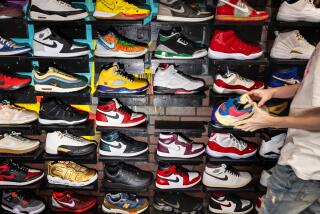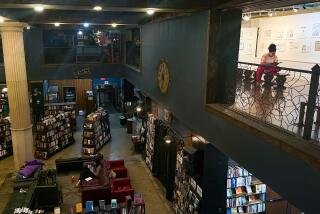Column: How badly are we being ripped off on eyewear? Former industry execs tell all
Charles Dahan knows from firsthand experience how badly people get ripped off when buying eyeglasses.
He was once one of the leading suppliers of frames to LensCrafters, before the company was purchased by optical behemoth Luxottica. He also built machines that improved the lens-manufacturing process.
In other words, Dahan, 70, knows the eyewear business from start to finish. And he doesnât like whatâs happened.
âThere is no competition in the industry, not anymore,â he told me. âLuxottica bought everyone. They set whatever prices they please.â
Dahan, who lives in Potomac, Md., was responding to a column I recently wrote about why consumer prices for frames and lenses are so astronomically high, with markups often approaching 1,000%.
I noted that if you wear designer glasses, thereâs a very good chance youâre wearing Luxottica frames.
The companyâs owned and licensed brands include Armani, Brooks Brothers, Burberry, Chanel, Coach, DKNY, Dolce & Gabbana, Michael Kors, Oakley, Oliver Peoples, Persol, Polo Ralph Lauren, Ray-Ban, Tiffany, Valentino, Vogue and Versace.
Along with LensCrafters, Luxottica also runs Pearle Vision, Sears Optical, Sunglass Hut and Target Optical, as well as the insurer EyeMed Vision Care.
And Italyâs Luxottica now casts an even longer shadow over the eyewear industry after merging last fall with Franceâs Essilor, the worldâs leading maker of prescription eyeglass lenses and contact lenses. The combined entity is called EssilorLuxottica.
Just so you know up front, I reached out to both Luxottica and its parent company with what Dahan told me. I asked if theyâd like to respond to his specific points or to speak generally about optical pricing.
Neither company responded, which was the same response I received the last time I contacted them.
Apparently EssilorLuxottica feels no need to defend its business practices. Or it understands that no reasonable defense is possible.
Dahan, a chemical engineer by training, established a company called Custom Optical in 1977 after designing a machine capable of making prescription lenses appear thinner.
In short order he also was designing plastic and metal frames, and proposed to LensCrafters in 1985 that he supply the then-independent company.
âThey bought my lens machines, and soon I was selling them a few models of frames,â Dahan said. âThose were successful, so they kept buying more.â
Buying glasses online can save you a lot of money. Hereâs how to do it Âť
Eventually, he said, his company was supplying LensCrafters with about 20% of its frames. âThey called me their crown jewel,â Dahan said.
E. Dean Butler, the founder of LensCrafters, remembers Dahan as âa real go-getter.â
âHe was a key supplier â good product at reasonable prices,â Butler, 74, said in a phone interview from Berlin, where he was meeting with optical-industry contacts.
Heâs no longer affiliated with LensCrafters. These days heâs based in England, but serves as a consultant to optical businesses worldwide.
Both Butler and Dahan acknowledged what most consumers have long suspected: that the prices we pay for eyewear in no way reflect the actual cost of making frames and lenses.
When he was in the business, in the 1980s and â90s, Dahan said it cost him between $10 and $16 to manufacture a pair of quality plastic or metal frames.
Lenses, he said, might cost about $5 a pair to produce. With fancy coatings, that could boost the price all the way to $15.
He said LensCrafters would turn around and charge $99 for completed glasses that cost $20 or $30 to make â and this was well below what many independent opticians charged. Nowadays, he said, those same glasses at LensCrafters might cost hundreds of dollars.
Butler said he recently visited factories in China where many glasses for the U.S. market are manufactured. Improved technology has made prices even lower than what Dahan recalled.
âYou can get amazingly good frames, with a Warby Parker level of quality, for $4 to $8,â Butler said. âFor $15, you can get designer-quality frames, like what youâd get from Prada.â
And lenses? âYou can buy absolutely first-quality lenses for $1.25 apiece,â Butler said.
Yet those same frames and lenses might sell in the United States for $800.
Butler laughed. âI know,â he said. âItâs ridiculous. Itâs a complete rip-off.â
In 1995, Luxottica purchased LensCraftersâ parent company, U.S. Shoe Corp., for $1.4 billion. The goal wasnât to get into the shoe business. It was to take control of LensCraftersâ hundreds of stores nationwide.
Dahan said things went downhill for him after that. Luxottica increasingly emphasized its own frames over those of outside suppliers, he said, and Custom Opticalâs sales plunged. Dahan was forced to close his business in 2001.
âIt wasnât just me,â he said. âIt happened to a lot of companies. Look at Oakley.â
Indeed, the California maker of premium sunglasses was embraced by skiers and other outdoorsy types after it released its first sunglasses in 1984.
It raised $230 million with an initial public offering of stock in 1995. Its biggest customer by far was Sunglass Hut, which, like LensCrafters, had stores in malls across the country.
Luxottica purchased Sunglass Hut in early 2001. It promptly told Oakley it wanted to pay significantly lower wholesale prices or it would reduce its orders and push its own brands instead.
Within months, Oakley acknowledged to shareholders that the talks hadnât gone well and that Luxottica was slashing its orders.
âWe have made every reasonable effort to establish a mutually beneficial business partnership with Luxottica, but it is clear from this weekâs surprising actions that our efforts have been ignored,â Oakleyâs management said in a statement at the time.
The companyâs stock immediately lost more than a third of its value.
Luxottica acquired Oakley a few years later, adding it to Ray-Ban, which Luxottica obtained in 1999.
âThatâs how they gained control of so many brands,â Dahan said. âIf you donât do what they want, they cut you off.â
Again, no one at Luxottica responded to my request for comment.
As Iâve previously observed, online glasses sales hold potential for pushing retail eyewear prices lower, but the e-glasses industry still has a ways to go before posing a threat to the likes of EssilorLuxottica.
It can be a challenge buying something so central to oneâs appearance without first trying it on or receiving hands-on help with fitting.
In the meantime, Dahan and Butler told me, federal authorities should step up and prevent price gouging for eyewear â just as theyâve done with other healthcare products, such as EpiPens.
âFederal officials fell asleep at the wheel,â Dahan said. âThey should never have allowed all these companies to roll into one. It destroyed competition.â
Butler said it should be clear from EssilorLuxotticaâs practices that the company has too much market power. âIf thatâs not a monopoly,â he said, âI donât know what is.â
I couldnât agree more. Regulators are currently wringing their hands over further consolidation in the wireless industry, with a proposed merger between Sprint and T-Mobile raising the prospect of just three major carriers.
The eyewear market is in considerably worse shape.
That should be clear to anyone.
David Lazarusâ column runs Tuesdays and Fridays. He also can be seen daily on KTLA-TV Channel 5 and followed on Twitter @Davidlaz. Send your tips or feedback to [email protected].
More to Read
Inside the business of entertainment
The Wide Shot brings you news, analysis and insights on everything from streaming wars to production â and what it all means for the future.
You may occasionally receive promotional content from the Los Angeles Times.











